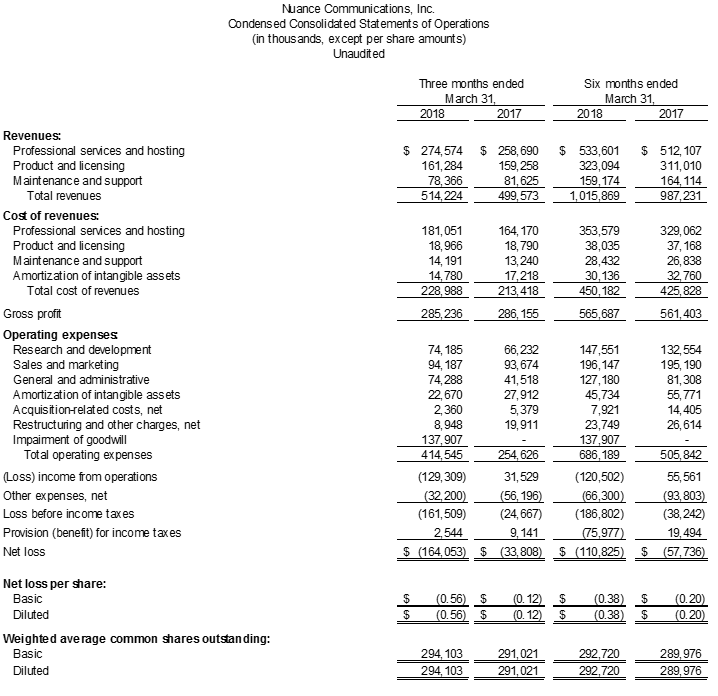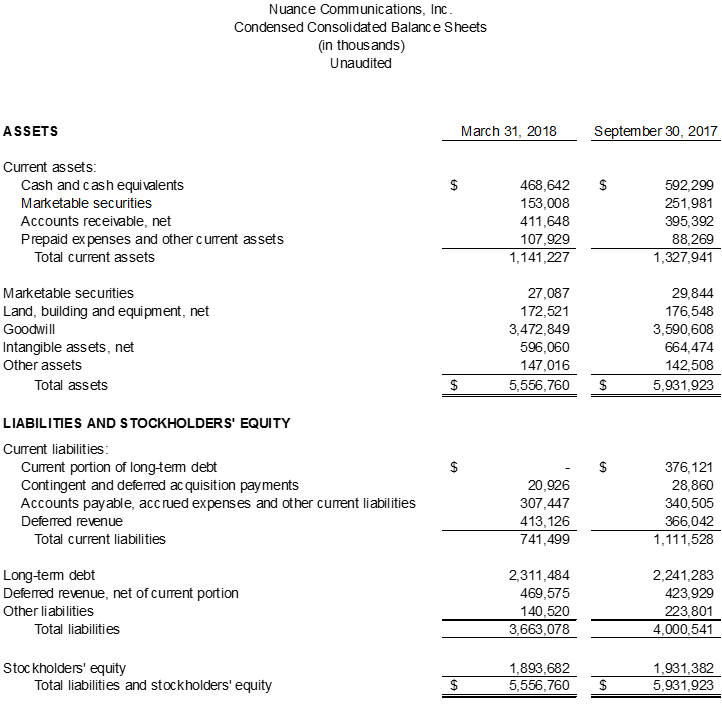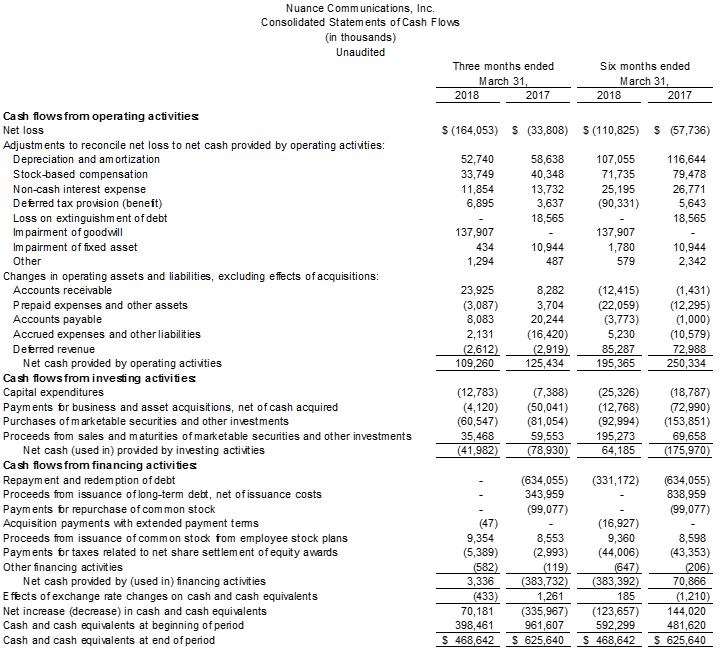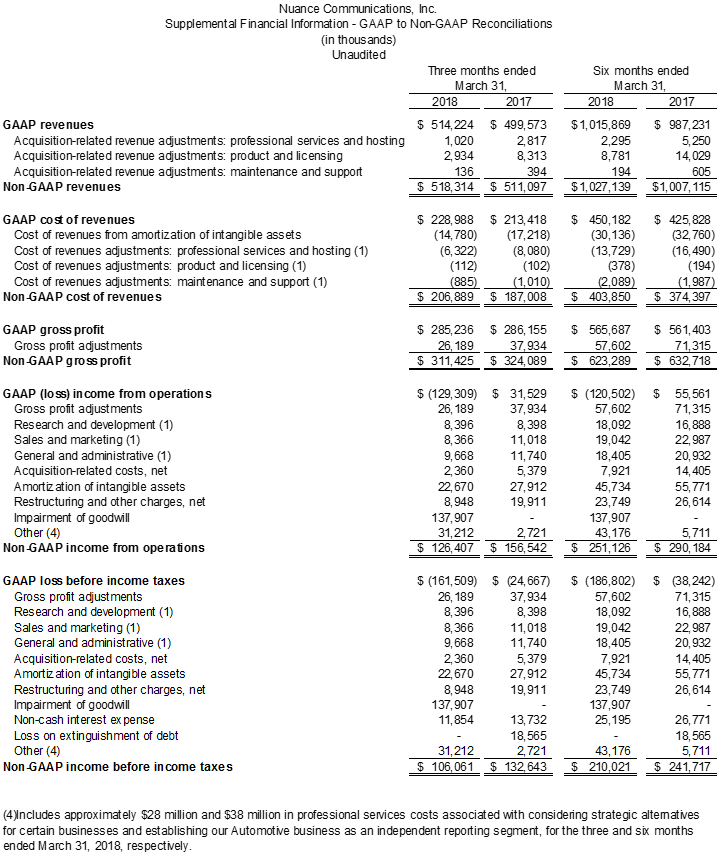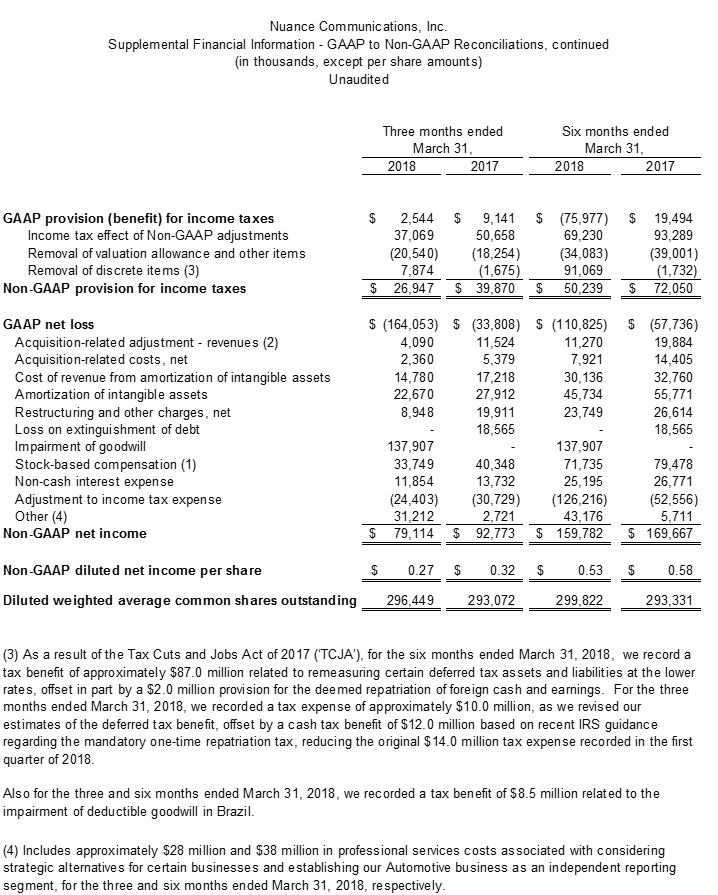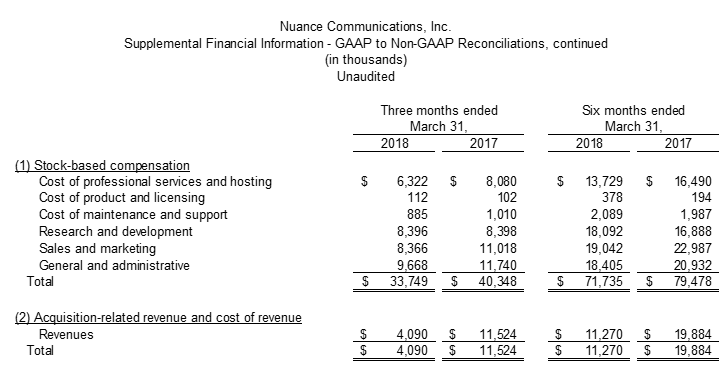BURLINGTON, Mass., May 9, 2018 – Nuance Communications, Inc. (NASDAQ: NUAN) today announced financial results for its second quarter fiscal year 2018, the three months ending March 31, 2018.
“We are pleased with the progress in our business and first-half results, especially the early returns from our investments and focus on our growth businesses,” said Dan Tempesta, Nuance’s chief financial officer. “This strategy is producing measurable results, driving organic revenue growth for the second sequential quarter and producing non-GAAP revenue and EPS in line with our guidance for the quarter.”
During the quarter, Nuance made progress in key vertical industries and growth businesses, including:
- Next-generation automotive interface and user experience offerings showcased with Daimler and Toyota;
- Significant, continued growth in the Dragon Medical cloud platform;
- Introduction of new core engine capabilities that include AI, voice recognition and text-to-speech capabilities for human-like dialog for Enterprise customers;
- Enhancements to its voice biometrics offerings leveraging deep neural networks; and,
- New design wins for Nuance’s AI and virtual assistant offerings with key customers, including AT&T, BMW, Cisco, Ford, Geely and Wells Fargo.
“In just a few weeks, my conviction about the potential of this company has been affirmed. There is real momentum in the core business, making it an exciting opportunity to step in at this pivotal moment,” said Mark Benjamin, Nuance’s chief executive officer. “A top priority is to work with the team to take a comprehensive look at Nuance’s entire portfolio, so we can quickly make smart choices on how to accelerate our momentum in growth businesses, deliver innovations for customers, and generate value for our shareholders.”
Second Quarter Performance Highlights
On a GAAP basis:
- GAAP revenue of $514.2 million, up 3% compared to $499.6 million a year ago, with 71% of total GAAP revenue as recurring revenue, compared to 74% a year ago.
- The Company recognized a goodwill impairment of $137.9 million in the quarter related to two businesses, Subscriber Revenue Services (SRS) and Devices, which affected GAAP results.
- GAAP net loss of $(164.1) million, or $(0.56) per share, compared to a loss of $(33.8) million, or $(0.12) per share, in the second quarter of fiscal year 2017.
- GAAP operating margin of (25.1)%, compared to 6.3% in the second quarter of fiscal year 2017.
- Cash flow from operations of $109.3 million in the second quarter of fiscal year 2018, compared to $125.4 million in the second quarter of fiscal year 2017.
On a Non-GAAP basis:
- Non GAAP revenue of $518.3 million, up 1%, compared to $511.1 million in the second quarter of fiscal year 2017.
- Organic revenue growth of 1% compared to the prior year, led by 8% growth in Healthcare and 12% growth in Automotive.
- Net new bookings of $376.6 million, down 8%, from $410.4 million a year ago.
- Non-GAAP recurring revenue of 71% of¬ total non-GAAP revenue, compared to 75% a year ago.
- Non-GAAP net income of $79.1 million, or $0.27 per diluted share, compared to non-GAAP net income of $92.8 million, or $0.32 per diluted share, in the second quarter of fiscal year 2017.
- Non GAAP operating margin of 24.4%, down from 30.6% in the second quarter of fiscal year 2017.
- Cash flow from operations as a percentage of non-GAAP net income was 138% of non-GAAP net income.
Company Discusses Changes in Business and Outlook
Beginning this quarter, the Company is reporting results in five segments: Healthcare, Enterprise, Automotive, Imaging and Other. The Other segment includes Nuance’s Subscriber Revenue Services (SRS) and Devices businesses. Nuance’s Enterprise segment now includes Dragon TV solutions. The changes to Nuance’s reporting segments are part of the Company’s ongoing actions to simplify the business, more efficiently address its best market opportunities and improve transparency for shareholders.
In the second quarter, as noted, the Company recorded goodwill impairments of $137.9 associated with its SRS and Devices businesses. An impairment of $102.8 million for the SRS business is the result of reduced demand for the Company’s services among mobile carriers, primarily in India and Brazil, due to dramatic shifts in their business models. An impairment of $35.1 for the Devices business is the result of an impairment evaluation, conducted in conjunction with the reorganization of Nuance’s reporting segments, that found the carrying value of this business exceeded its estimated fair value.
Due primarily to the significant changes in Nuance’s SRS business and outlook, the Company revised its fiscal year 2018 growth estimates to 2% to 4% organic growth from 3% to 5% organic growth. Despite these changes, the Company is reiterating its expectation for 5% to 7% growth in net new bookings in fiscal year 2018.
For a complete discussion on Nuance’s second quarter results and business outlook, please see the Company’s Prepared Remarks document available at http://www.nuance.com/earnings-results/
Please refer to the “Discussion of Non-GAAP Financial Measures,” and “GAAP to Non-GAAP Reconciliations,” included elsewhere in this release, for more information regarding the company’s use of non-GAAP.
Conference Call and Prepared Remarks
Nuance provides prepared remarks in combination with its press release. These remarks are offered to provide shareholders and analysts with additional time and detail for analyzing results in advance of the company’s quarterly conference call. The remarks will be available at http://www.nuance.com/earnings-results/ in conjunction with the press release.
Nuance will host an investor conference call today that will begin at 5:00 p.m. ET and will include brief comments followed by questions and answers. To access the live broadcast, please visit the Investor Relations section of Nuance’s website at http://investors.nuance.com. The call can also be heard by dialing 800-230-1074 or 612-234-9960 at least five minutes prior to the call and referencing code 448075. A replay will be available within 24 hours of the announcement via the webcast link at http://investors.nuance.com or by dialing 800-475-6701 or 320-365-3844 and using the access code 448075.
About Nuance Communications, Inc.
Nuance Communications, Inc. (NASDAQ: NUAN) is the pioneer and leader in conversational AI innovations that bring intelligence to everyday work and life. The Company delivers solutions that can understand, analyze and respond to human language to increase productivity and amplify human intelligence. With decades of domain and artificial intelligence expertise, Nuance works with thousands of organizations – in global industries that include healthcare, telecommunications, automotive, financial services, and retail – to create stronger relationships and better experiences for their customers and workforce. For more information, please visit www.nuance.com.
Trademark reference: Nuance and the Nuance logo are registered trademarks or trademarks of Nuance Communications, Inc. or its affiliates in the United States and/or other countries. All other trademarks referenced herein are the property of their respective owners.
Safe Harbor and Forward-Looking Statements
Statements in this document regarding future performance and our management’s future expectations, beliefs, goals, plans or prospects constitute forward-looking statements within the meaning of the Private Securities Litigation Reform Act of 1995. Any statements that are not statements of historical fact (including statements containing the words “believes,” “plans,” “anticipates,” “expects,” or “estimates” or similar expressions) should also be considered to be forward-looking statements. There are a number of important factors that could cause actual results or events to differ materially from those indicated by such forward-looking statements, including but not limited to: fluctuations in demand for our existing and future products; further unanticipated costs resulting from the FY17 malware incident including potential costs associated with litigation or governmental investigations that may result from the incident; our ability to control and successfully manage our expenses and cash position; our ability to develop and execute in a timely manner our productivity and cost initiatives; the effects of competition, including pricing pressure, and changing business models in the markets and industries we serve; changes to economic conditions in the United States and internationally; uncertainties associated with the transition of our chief executive officer; the imposition of tariffs or other trade measures particularly between the United States and China; potential future impairment charges related to our newly reorganized business reporting units; fluctuating currency rates; possible quality issues in our products and technologies; our ability to successfully integrate operations and employees of acquired businesses; the conversion rate of bookings into revenue; the ability to realize anticipated synergies from acquired businesses; and the other factors described in our Form 10-Q for the period ended December 31, 2017. We disclaim any obligation to update any forward-looking statements as a result of developments occurring after the date of this document.
Definitions of Bookings and Net New Bookings
Bookings. Bookings represent the estimated gross revenue value of transactions at the time of contract execution, except for maintenance and support offerings. For fixed price contracts, the bookings value represents the gross total contract value. For contracts where revenue is based on transaction volume, the bookings value represents the contract price multiplied by the estimated future transaction volume during the contract term, whether or not such transaction volumes are guaranteed under a minimum commitment clause. Actual results could be different than our initial estimates. The maintenance and support bookings value represents the amounts billed in the period the customer is invoiced. Because of the inherent estimates required to determine bookings and the fact that the actual resultant revenue may differ from our initial bookings estimates, we consider bookings one indicator of potential future revenue and not as an arithmetic measure of backlog.
Net new bookings. Net new bookings represents the estimated revenue value at the time of contract execution from new contractual arrangements or the estimated revenue value incremental to the portion of value that will be renewed under pre-existing arrangements. Constant currency for net new bookings is calculated using current period net new bookings denominated in currencies other than United States dollars, converted into United States dollars using the average exchange rate for those currencies from the prior year period rather than the actual exchange rate in effect during the current period.
Discussion of non-GAAP Financial Measures
We believe that providing the non-GAAP information to investors, in addition to the GAAP presentation, allows investors to view the financial results in the way management views the operating results. We further believe that providing this information allows investors to not only better understand our financial performance, but more importantly, to evaluate the efficacy of the methodology and information used by management to evaluate and measure such performance. The non-GAAP information included in this press release should not be considered superior to, or a substitute for, financial statements prepared in accordance with GAAP.
We utilize a number of different financial measures, both Generally Accepted Accounting Principles (“GAAP”) and non-GAAP, in analyzing and assessing the overall performance of the business, for making operating decisions and for forecasting and planning for future periods. Our annual financial plan is prepared both on a GAAP and non-GAAP basis, and the non-GAAP annual financial plan is approved by our board of directors. Continuous budgeting and forecasting for revenue and expenses are conducted on a consistent non-GAAP basis (in addition to GAAP) and actual results on a non-GAAP basis are assessed against the non-GAAP annual financial plan. The board of directors and management utilize these non-GAAP measures and results (in addition to the GAAP results) to determine our allocation of resources. In addition, and as a consequence of the importance of these measures in managing the business, we use non-GAAP measures and results in the evaluation process to establish management’s compensation. For example, our annual bonus program payments are based upon the achievement of consolidated non-GAAP revenue and consolidated non-GAAP earnings per share financial targets. We consider the use of non-GAAP revenue helpful in understanding the performance of our business, as it excludes the purchase accounting impact on acquired deferred revenue and other acquisition-related adjustments to revenue. We also consider the use of non-GAAP earnings per share helpful in assessing the organic performance of the continuing operations of our business. By organic performance we mean performance as if we had owned an acquired business in the same period a year ago. By constant currency organic performance, we mean performance excluding the effect of current foreign currency rate fluctuations. By continuing operations, we mean the ongoing results of the business excluding certain unplanned costs. While our management uses these non-GAAP financial measures as a tool to enhance their understanding of certain aspects of our financial performance, our management does not consider these measures to be a substitute for, or superior to, the information provided by GAAP financial statements. Consistent with this approach, we believe that disclosing non-GAAP financial measures to the readers of our financial statements provides such readers with useful supplemental data that, while not a substitute for GAAP financial statements, allows for greater transparency in the review of our financial and operational performance. In assessing the overall health of the business during the three and six months ended March 31, 2018 and 2017, our management has either included or excluded items in seven general categories, each of which is described below.
Acquisition-related revenue and cost of revenue.
We provide supplementary non-GAAP financial measures of revenue that include revenue that we would have recognized but for the purchase accounting treatment of acquisition transactions. Non-GAAP revenue also includes revenue that we would have recognized had we not acquired intellectual property and other assets from the same customer. Because GAAP accounting requires the elimination of this revenue, GAAP results alone do not fully capture all of our economic activities. These non-GAAP adjustments are intended to reflect the full amount of such revenue. We include non-GAAP revenue and cost of revenue to allow for more complete comparisons to the financial results of historical operations, forward-looking guidance and the financial results of peer companies. We believe these adjustments are useful to management and investors as a measure of the ongoing performance of the business because, although we cannot be certain that customers will renew their contracts, we have historically experienced high renewal rates on maintenance and support agreements and other customer contracts. Additionally, although acquisition-related revenue adjustments are non-recurring with respect to past acquisitions, we generally will incur these adjustments in connection with any future acquisitions.
Acquisition-related costs, net.
In recent years, we have completed a number of acquisitions, which result in operating expenses, which would not otherwise have been incurred. We provide supplementary non-GAAP financial measures, which exclude certain transition, integration and other acquisition-related expense items resulting from acquisitions, to allow more accurate comparisons of the financial results to historical operations, forward looking guidance and the financial results of less acquisitive peer companies. We consider these types of costs and adjustments, to a great extent, to be unpredictable and dependent on a significant number of factors that are outside of our control. Furthermore, we do not consider these acquisition-related costs and adjustments to be related to the organic continuing operations of the acquired businesses and are generally not relevant to assessing or estimating the long-term performance of the acquired assets. In addition, the size, complexity and/or volume of past acquisitions, which often drives the magnitude of acquisition related costs, may not be indicative of the size, complexity and/or volume of future acquisitions. By excluding acquisition-related costs and adjustments from our non-GAAP measures, management is better able to evaluate our ability to utilize our existing assets and estimate the long-term value that acquired assets will generate for us. We believe that providing a supplemental non-GAAP measure, which excludes these items allows management and investors to consider the ongoing operations of the business both with, and without, such expenses.
These acquisition-related costs fall into the following categories: (i) transition and integration costs; (ii) professional service fees and expenses; and (iii) acquisition-related adjustments. Although these expenses are not recurring with respect to past acquisitions, we generally will incur these expenses in connection with any future acquisitions. These categories are further discussed as follows:
(i) Transition and integration costs. Transition and integration costs include retention payments, transitional employee costs, and earn-out payments treated as compensation expense, as well as the costs of integration-related activities, including services provided by third-parties.
(ii) Professional service fees and expenses. Professional service fees and expenses include financial advisory, legal, accounting and other outside services incurred in connection with acquisition activities, and disputes and regulatory matters related to acquired entities.
(iii) Acquisition-related adjustments. Acquisition-related adjustments include adjustments to acquisition-related items that are required to be marked to fair value each reporting period, such as contingent consideration, and other items related to acquisitions for which the measurement period has ended, such as gains or losses on settlements of pre-acquisition contingencies.
Amortization of acquired intangible assets.
We exclude the amortization of acquired intangible assets from non-GAAP expense and income measures. These amounts are inconsistent in amount and frequency and are significantly impacted by the timing and size of acquisitions. Providing a supplemental measure which excludes these charges allows management and investors to evaluate results “as-if” the acquired intangible assets had been developed internally rather than acquired and, therefore, provides a supplemental measure of performance in which our acquired intellectual property is treated in a comparable manner to our internally developed intellectual property. Although we exclude amortization of acquired intangible assets from our non-GAAP expenses, we believe that it is important for investors to understand that such intangible assets contribute to revenue generation. Amortization of intangible assets that relate to past acquisitions will recur in future periods until such intangible assets have been fully amortized. Future acquisitions may result in the amortization of additional intangible assets.
Non-cash expenses.
We provide non-GAAP information relative to the following non-cash expenses: (i) stock-based compensation; and (ii) non-cash interest. These items are further discussed as follows:
(i) Stock-based compensation. Because of varying valuation methodologies, subjective assumptions and the variety of award types, we believe that excluding stock-based compensation allows for more accurate comparisons of operating results to peer companies, as well as to times in our history when stock-based compensation was more or less significant as a portion of overall compensation than in the current period. We evaluate performance both with and without these measures because compensation expense related to stock-based compensation is typically non-cash and the options and restricted awards granted are influenced by the Company’s stock price and other factors such as volatility that are beyond our control. The expense related to stock-based awards is generally not controllable in the short-term and can vary significantly based on the timing, size and nature of awards granted. As such, we do not include such charges in operating plans. Stock-based compensation will continue in future periods.
(ii) Non-cash interest. We exclude non-cash interest because we believe that excluding this expense provides senior management, as well as other users of the financial statements, with a valuable perspective on the cash-based performance and health of the business, including the current near-term projected liquidity. Non-cash interest expense will continue in future periods.
Other expenses.
We exclude certain other expenses that result from unplanned events outside the ordinary course of continuing operations, in order to measure operating performance and current and future liquidity both with and without these expenses. By providing this information, we believe management and the users of the financial statements are better able to understand the financial results of what we consider to be our organic, continuing operations. Included in these expenses are items such as restructuring charges, asset impairments and other charges (credits), net. These items include losses from extinguishing our convertible debt. Other items such as consulting and professional services fees related to assessing strategic alternatives and our transformation program, implementation of the new revenue recognition standard (ASC 606), and expenses associated with the malware incident and remediation thereof are also excluded.
Non-GAAP income tax provision.
Effective Q2 2017, we changed our method of calculating our non-GAAP income tax provision. Under the prior method, we calculated our non-GAAP tax provision using a cash tax method to reflect the estimated amount we expected to pay or receive in taxes related to the period, which is equivalent to our GAAP current tax provision. Under the new method, our non-GAAP income tax provision is determined based on our non-GAAP pre-tax income. The tax effect of each non-GAAP adjustment, if applicable, is computed based on the statutory tax rate of the jurisdiction to which the adjustment relates. Additionally, as our non-GAAP profitability is higher based on the non-GAAP adjustments, we adjust the GAAP tax provision to remove valuation allowances and related effects based on the higher level of reported non-GAAP profitability. We also exclude from our non-GAAP tax provision certain discrete tax items as they occur, which in fiscal year 2018 also includes certain impacts from the Tax Cuts and Jobs Act of 2017.
Contact Information
Richard Mack
Nuance Communications, Inc.
Tel: 781-565-5000
Email:richard.mack@nuance.com
Suzanne DuLong
Nuance Communications, Inc.
Tel: 781-565-5077
Email:suzanne.dulong@nuance.com
Financial Tables Follow
